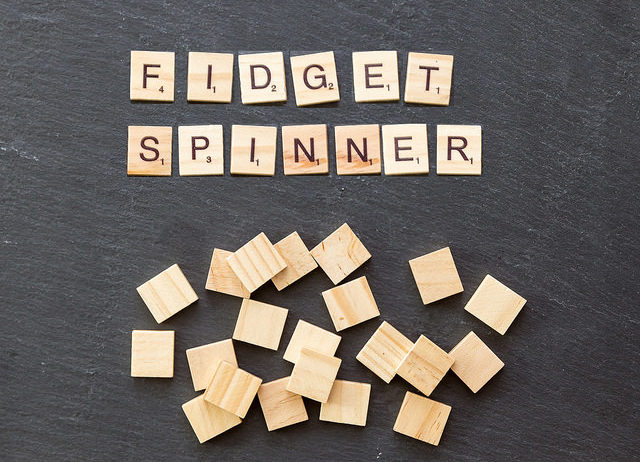Fidget spinners are the latest toy designed to focus a child’s energy. But there is a fair amount of controversy when it comes to fidget spinners for kids with ADHD, and whether these toys actually help kids with the type of attention needed to listen to a teacher, complete a writing assignment, or efficiently do their homework. Fidget spinners seem to have arrived out of nowhere, but there is a long-standing tradition of using sensory-based tools to address the needs of kids with ADHD.
Two sides of the same coin.
Psychologists and occupational therapists often look at two sides of the same coin in their treatment approaches. Most sensory tools and strategies have been popularized by occupational therapists, who often identify sensory concerns as the underlying cause of excess movement, inattention, and hyperactivity. Psychologists, however, tend to look at these issues and diagnose ADHD rather than Developmental Coordination Disorder or a sensory disorder.
Playing with a fidget spinner requires some degree of visual attention. While there is some enjoyment in the feel and sound of playing with it, fidget spinners are primarily a visual toy. It is widely understood that visual stimuli — televisions and computer screens, for example — impair attention on homework and other academics.
Can visual stimulation improve focus?

Image courtesy Flickr user Ryan Dickey
While visual attention is crucial for most schoolwork, there are many other types of attention, including auditory, sensory, kinesthetic, and social/emotional attention. Kids with ADHD may have difficulty with one or more of these types of attention. In my clinical practice as a child psychologist, I have observed that many kids with ADHD can focus better on a conversation when they have something to do with their hands or are involved in some type of movement. Sometimes tossing a football or allowing kids to play with a small toy in their hands can be helpful when it comes to keeping the focus on a back-and-forth discussion. I give some of the kids who leave my office a polished semi-precious gemstone that they can keep in their pockets as a tool to help them with focus and perhaps reduce stress.
My own experience is that having something to fidget with, such as a pencil to twirl or even drinking a cup of tea can help me in tasks involving creativity, planning, and organizing my ideas. Those same actions are often not very helpful when it comes to getting my ideas onto paper.
I have also noticed that movement helps me in generating ideas and even in writing. Because I draft much of my articles and blog posts using dictation tools, I can move around as I write. I would hypothesize that many kids with ADHD would benefit from being active as they work as well, but they do not have the necessary skills and resources to get their ideas onto paper while moving. This is why I so strongly recommend teaching dictation skills for kids with ADHD who have problems writing. Our team at LearningWorks for Kids provides this type of dictation training. You can learn more about it by emailing us at techtraining@learningworksforkids.com.
One size does not fit all.
Working with thousands of kids with ADHD has taught me that no one strategy to improve focus works for all kids. Kids with ADHD are not all the same and have many different presentations, strengths and weakness. Undoubtedly some kids with ADHD could improve their focus by using a fidget spinner, but it may be that these fidget spinners help them with specific aspects of attention such as auditory attention or social/emotional attention. I strongly question whether fidget spinners really help kids with visual attention.
Fortunately, there are many tools, technologies, and strategies that can improve attention in kids with ADHD. Many kids need complete silence and solitude in order to do their homework, while others benefit from sitting at the kitchen table with some background household noise. Some kids cannot do their homework while music is playing in the background, while others find that their concentration is enhanced by this type of background music. Movement breaks may help some kids, while others may have difficulty transitioning back to their work.
When it comes to fidget spinners for kids with ADHD, the best parallels we have are other forms of visual stimulation such as television, texting, or computer screens. There is a consensus that other types of visual stimulation interfere with focus. The fidget spinner, at least when the child is watching it, might be best categorized as this type of visual stimulation and therefore is probably unhelpful for improving attention and focus. For a look at Dr. Kulman’s research, see “Do Fidget Spinners Really Work?”
Featured image: Flickr user Marco Verch




